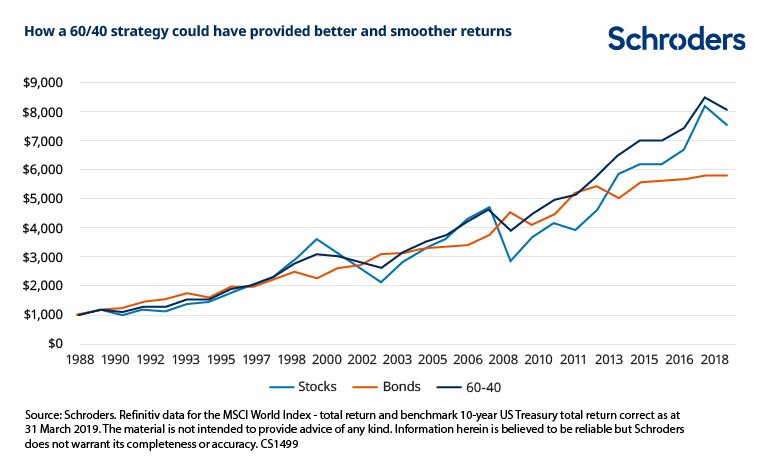Can a 60/40 split portfolio deliver better outcomes?
For decades financial planners and investors have abided by the 60/40 rule and calculations made by Schroders illustrate why, but has it had its time?

Authors
Recent decades have been a tumultuous time for investors. In the last 20 years alone we have experienced two of the biggest stock market crashes in history – the bursting of the dotcom bubble at the turn of the millennium and the financial crisis in 2008.
Smoothing returns and avoiding losses has been a crucial imperative for investors, which is why many have adopted the 60/40 rule.
In its simplest form, the 60/40 rule means having 60% of your portfolio invested in potentially higher risk, historically higher return, assets such as stocks and the other 40% invested in lower risk, but also traditionally lower return, assets such government bonds.
The theory is that a 60/40 portfolio should provide equity like returns while smoothing out the extreme highs and lows (volatility) that come with an equity only portfolio.
Schroders’ calculations show that investment, over the last 30 years, based on a 60/40 strategy, would have been effective both in terms of smoothing out volatility (the main aim) but also delivering a superior return.
A $1,000 investment made at the end of 1988, using three different approaches involving stocks, bonds and a 60/40 combination of the two, could have been expected to perform as follows:
- $1,000, 100% invested in stocks now = $7,554. A return of 7.2% a year.
- $1,000, 100% invested in government bonds now = $5,806. An annual return of 6.2%.
- $1,000, 60% invested in stocks, 40% in government bonds now = $8,091. An annual return of 7.5%.
In the example, stocks are represented by the MSCI World Total Return Index (global developed markets) and bonds by the benchmark 10-year US Treasury bond. Returns have not been adjusted for inflation or trading costs.
Of course, past performance is not a guide to what investors can expect in the future.

Rebalancing: The secret to making the 60/40 rule work
To make the strategy work investors need to tweak their portfolio at least once a year, to ensure it retains its roughly 60/40 split. This action is known in investment circles as rebalancing. In practical terms, it involves selling some outperforming assets and re-investing the proceeds in the underperforming ones, so that the mix of stocks and bonds remains 60/40.
You need to do this because, for instance, if stocks have a good year and bonds have a bad one, equities could end up representing a far bigger percentage of your portfolio than 60%. Left alone, you could unwittingly end up with a portfolio heavily weighted towards one asset. And that leaves you exposed to greater risk.
In this example, by selling outperforming stocks and buying underperforming bonds, the portfolio would again be balanced. In an ideal world, the underperforming assets would then begin to perform better, enhancing the total portfolio return, while also smoothing out volatility (extreme high and lows price moves).
Does the 60/40 strategy still work?
Over the last decade a 60/40 portfolio could have returned 7.5% annually. However, record low interest rates and other policy initiatives employed by central banks, (such aa quantitative easing – adding more money into the financial system) to aid economic recovery, after the financial crisis, have distorted returns. The overall effect was a reduction in the return on government bonds.
For instance, a bonds only investment, since 2008, would have returned just 2.5%. This compares with a stocks only portfolio that would have returned 10.3%.
The low interest rate environment, combined with central bank monetary policy, has kept bond yields artificially low and pushed investors into riskier assets, such as stocks, in a search for higher returns.
The 10-year US Treasury yield fell from 9.5% in 1989 to 2.8% in 2018. The current dividend yield for global stocks is 4%. So an investor rebalancing a portfolio, selling outperforming stocks and buying underperforming bonds, isn’t seeing the level of returns that had been more usual historically.
Is there an argument for a different type of strategy?
Back in 2013, Warren Buffet, the billionaire investor and chief executive of the world’s largest financial services firm, Berkshire Hathaway, made waves. He said he was leaving instructions, that upon his passing, the trustees of the inheritance he leaves behind put 90% of the money into stocks and 10% into short-term government bonds.
Such a 90/10 strategy would certainly have paid off over the last decade. Since its low, in March 2009 during the financial crisis, the MSCI World index is up 242%. But being so heavily invested in equities is a very risky strategy. Investors adopting it would have to have the constitution to endure the roller-coaster ride that being a stock market investor entails.
Claire Walsh, Schroders Personal Finance Director, said while the 60/40 rule may not have provided the returns investors may have desired in recent years it imbues them with investment discipline.
“As the data shows, the 60/40 rule could still achieve a decent return but since the introduction of low interest rates, from the time of the financial crisis, it has been less effective. However, there are still benefits in this approach.
“For instance, using the 60/40 rule and regularly rebalancing could prevent you from making classic investment errors, such as panic buying and euphoric selling. Much like saving on a monthly basis, regular rebalancing teaches you to be disciplined with your investing.
“Arguably the real benefit of the 60/40 rule is psychological. Fluctuating markets are distressing. Rebalancing can give investors greater peace of mind. It can help them avoid the temptation to fiddle too much with their investments and stop them from selling at the bottom (because things are bad) and buying at the top.”
Authors
Topics